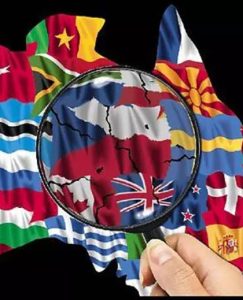Australia increasingly diverse, 2021 Census shows
Australia’s population has become larger and more culturally diverse over the past five years, according to data from the 2021 census.
The nation’s population increased by 2.2 million to 25.5 million between 2016 and 2021 as more than a million people moved to Australia from overseas, the census data shows.
It shows the population has doubled over the past fifty years. And for the first time, more than half of Australians (51.5 per cent) were either born overseas or had at least one parent born in another country.
India leapfrogged China and New Zealand to become the third-largest country of birth behind Australia and Britain; while 5.5 million people speak a language other than English at home, an increase of almost 800,000.
The census also revealed 27.6 per cent of the population were born overseas and 61,860 international visitors were in Australia during the Census collection period in October 2021.
Among people born overseas, the fastest growing new communities were from Nepal, India, Pakistan, Iraq and the Philippines.
 The top five languages used at home, other than English, were Mandarin (2.7 per cent), Arabic (1.4 per cent), Vietnamese (1.3 per cent), Cantonese (1.2 per cent) and Punjabi (0.9 per cent).
The top five languages used at home, other than English, were Mandarin (2.7 per cent), Arabic (1.4 per cent), Vietnamese (1.3 per cent), Cantonese (1.2 per cent) and Punjabi (0.9 per cent).
The top five ancestries were English (33.0 per cent), Australian (29.9 per cent), Irish (9.5 per cent), Scottish (8.6 per cent) and Chinese (5.5 per cent).
Victoria is the most diverse state in Australia with a third of the population born overseas. The proportion of foreign-born Victorians has increased over time from 22.5 per cent in 1971 to 28.3 per cent in 2016, and 30 per cent in 2021.
In 2021, the top five countries of birth in Victoria were: Australia (65 per cent); India (4 per cent); England (2.7 per cent); China (2.6 per cent), and; New Zealand (1.5 per cent).
The census also reveals that Australia is becoming less religious with the number of people identifying as Christians dropping below 50 per cent for first time.
The top five religious affiliations were: no religion (38.9 per cent), Catholic (20 per cent), Anglican (9.8 per cent), Islam (3.2 per cent) and Hinduism (2.7 per cent).
Close to 60 per cent of Baby Boomers (aged 55-74) said they were Christian compared with 30 per cent of Millennials (aged 25-39). A record 38.9 per cent of Australians said they had no religion – including 46 per cent of Millennials and 30.7 per cent of Baby Boomers.
Almost 80 per cent of Australian residents live in eastern Australia in New South Wales, Victoria, Queensland and the Australian Capital Territory.
NSW continues to be the largest state with over 8 million people, followed by Victoria with 6.5 million people.
The ACT had the fastest growth with a 14.4 per cent (57,102 people) increase since 2016.
Almost 70 per cent of people counted in the census were in capital cities and 33.1 per cent were in the rest of Australia.
Sydney remains the largest city in Australia with 5.2 million people, followed by Melbourne with 4.9 million people and Brisbane with 2.5 million people.
The median age of Australians is 38 years and males make up 49.3 per cent of the population, with a median age of 37 years, and females make up 50.7 per cent, with a median age of 39 years.
But the census shows Australia is undergoing a significant generational shift. Baby Boomers and Millennials each represent more than 5.4 million people, but the proportion of Millennials increasing. Baby Boomers now outnumber Millennials by just 5,662.
Millennials are of working age and are upskilling, representing 40 per cent of people attending vocational education, including TAFE.
Baby Boomers are providing care for other peoples’ children, often their grandchildren.
Around one in eight Baby Boomers reported caring for other peoples’ children, and of these, two thirds are female. They are also the generation most likely to volunteer and provide unpaid assistance to others.
Generation Z (aged 10-24) represent 18 per cent of the Australian and 30 per cent of the Aboriginal and Torres Strait Islander population.
According to the census data, 812,728 people identified as Aboriginal and/or Torres Strait Islander – an increase of over 25 per cent (25.2 per cent) since 2016, with Aboriginal and Torres Strait Islander people now representing 3.2 per cent of the Australian population.
The 2021 Census counted more than 10.8 million private dwellings across Australia with the average number of people per household decreasing from 2.6 in 2016 to 2.5 in 2021.
It found 5.5 million couple families, of which 53 per cent have children living with them and 47 per cent do not have children living with them.
There are 2.5 million families with children under the age of 15 and more than a million one parent families, 80 per cent of them with a female parent.
As a proportion of families this is increasing slowly, from under 15 per cent in 1996 to nearly 16 per cent in 2021.
About one-third of Australians have a diagnosed long-term health condition, with mental health issues – reported by one in 12 people – surpassing every other chronic illness.
Arthritis and asthma were the second and third most common long-term ailments, the census found.












